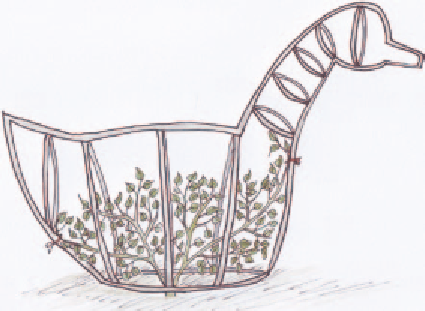Agriculture Reference
In-Depth Information
Plants with showy flowers are usually trained
as standards rather than the more detailed
topiary shapes.
Ensure that whatever you choose is suited
to the site. It is heartbreaking to spend hours
of effort only to see your masterpiece
destroyed by frost, sunburn or die back
through drought.
Trainingtopiaryshapes
If you are wishing to train a plant into a
standard, see below. The major difference
between a topiary shape and a standard is
that the former has a dense foliage base at
ground level; a standard is topiary on a trunk.
Figure 4.74
If you are using a wire frame to guide your
shape, tie appropriate branches to the frame with
bio-degradable string and remember to pinch out the tips
of
all
growth more than 5 to 8 cm long.
Standards-ballsonsticks
Many standards can be bought readymade.
They usually consist of a bushy or weeping
plant grafted onto a sturdy rootstock that
forms the trunk as with weeping or standard
roses (see page 78). Highly successful and
more natural-looking standards can be
grown, however, when the one plant forms
both the trunk and the 'ball' atop it.
Start with a young plant or struck cutting.
With a clear idea of the shape required, clip
off the ends of all the plant's stems into the
shape desired, but much smaller. This will
promote bushy growth and it is vital that
topiary be dense. A dense framework will
strengthen the ultimate structure. Continue
this regimen at regular intervals so that new
growth does not get longer than 5 to 8 cm
long before its tips are pinched out/clipped.
Plant selection
Choose a plant with a strong central stem
or leader. It may be an unbranched cutting
or seedling or a more advanced shrub with
the essential strong central stem that will
form the standard's trunk. Many plants
with showy flowers can be grown as
standards as the 'ball' on top of the long
trunk is a simple shape that shows off the
flowers and then can be clipped back into
shape (see Table 4.20). Information about
the plant selection for topiary shapes is
also relevant.
If a plant with large leaves such as
Laurus
nobilis
or bay tree is being used, trim back the
individual stems rather than clipping the
leaves, otherwise it will look ravaged.
If you are using a wire frame to guide the
ultimate shape, tie stems to the frame with
biodegradable string and don't neglect to
constantly pinch out the tips of any stems that
will form the 'body' of the shape. This may
seem unnecessarily slow but it will build a
solid structure to support the ultimate shape
(see Figure 4.74).

